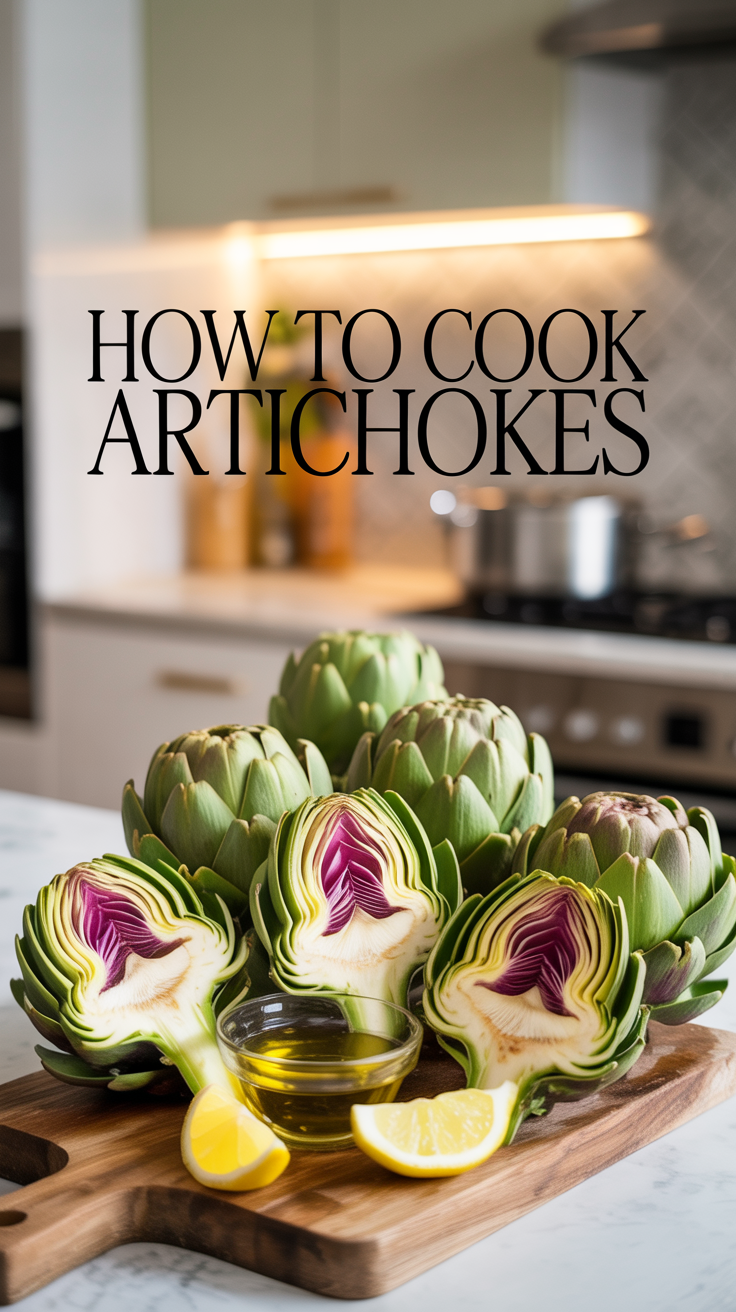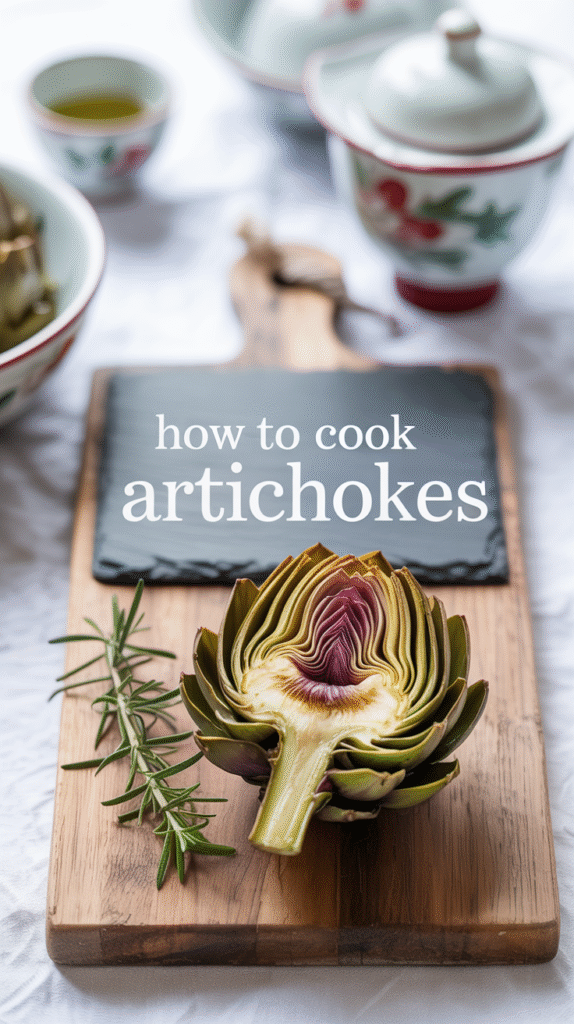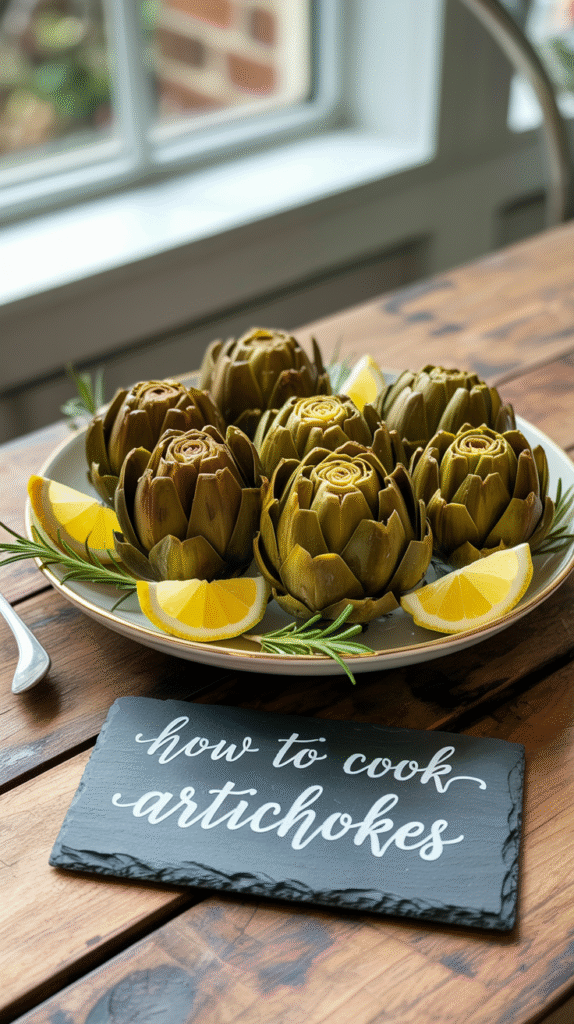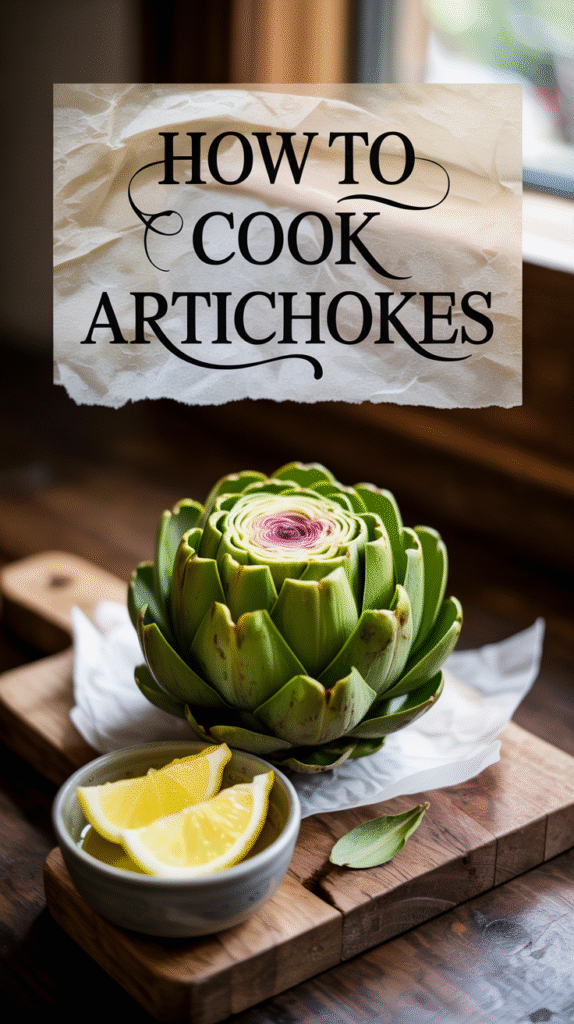Artichokes are a unique and delicious vegetable that can elevate any dish. Learning how to cook artichokes can seem daunting at first, but with a few simple techniques, you’ll find it’s not only easy but also quite enjoyable. Here are some methods, along with tips, to help you prepare these flavorful vegetables.
Choosing the Right Artichoke
Before cooking artichokes, selecting the right ones is crucial.
- Look for artichokes that are firm and heavy for their size.
- The leaves should be tightly packed and not wilted.
- Choose a vibrant green color, avoiding any with browning or dried-out tips.
Basic Preparation Steps
Cleaning and prepping artichokes takes a few simple steps:
- Rinse the artichokes under cold water to remove any dirt.
- Trim the stem so that the artichoke can stand upright.
- Cut about an inch off the top of the artichoke.
- Remove any small, tough leaves near the base.
- If desired, rub the cut areas with lemon juice to prevent browning.
Cooking Techniques
There are several popular methods for cooking artichokes, each bringing out their unique flavors.
Boiling
Boiling is a straightforward method that keeps artichokes tender and tasty.
- Fill a large pot with enough water to cover the artichokes, adding salt and lemon juice.
- Bring the water to a boil.
- Add the artichokes and reduce the heat to a simmer.
- Cook for 30-45 minutes, depending on their size.
- Artichokes are done when a leaf pulls off easily.
Steaming
Steaming helps preserve the nutrients while enhancing flavor.
- Fill a pot with about 2 inches of water and insert a steamer basket.
- Place the artichokes in the basket, cover, and bring to a boil.
- Steam for 25-40 minutes, checking for doneness.
- Serve with melted butter or dipping sauces.
Baking
Baking artichokes creates a lovely roasted flavor.
- Preheat your oven to 375°F (190°C).
- Cut the artichokes in half and remove the hairy choke from the center.
- Brush with olive oil, sprinkle with salt, and add garlic or herbs if desired.
- Bake on a lined baking sheet for 30-40 minutes, until tender and golden.
Flavor Pairings
Artichokes can be enjoyed with various flavors. Here are some classic pairings:
| Flavor | Pairing |
|---|---|
| Garlic | Olive oil, butter |
| Lemon | Parmesan cheese, herbs |
| Vinaigrette | Mustard, balsamic |
Storage Tips
If you have leftover cooked artichokes, store them properly to maintain freshness. Keep in an airtight container in the refrigerator, where they can last for 3-5 days. For longer storage, consider freezing them. Just blanch beforehand, then store in a freezer bag.
Get Inspired
Artichokes can be utilized in numerous dishes! Incorporate them into salads, pasta, or even on pizza. Check out some delicious artichoke recipes at Food Network for more inspiration.
Now that you know how to cook artichokes, it’s time to enjoy their rich flavor and health benefits. Experiment with different methods and flavor pairings to find what you love the most. Happy cooking!
The Nutritional Benefits of Artichokes
When it comes to nutritious vegetables, artichokes stand out as a powerhouse. These unique thistle-like vegetables offer a range of health benefits that can enhance your diet significantly. Below, you’ll explore the many nutritional perks that artichokes bring to the table.
Nutritional Profile
One medium-sized artichoke contains approximately:
| Nutrient | Amount per Artichoke |
|---|---|
| Calories | 60 |
| Carbohydrates | 13g |
| Fiber | 7g |
| Protein | 4g |
| Fat | 0.2g |
| Vitamin C | 15% DV |
| Folate | 24% DV |
| Magnesium | 10% DV |
High in Fiber
Artichokes are one of the richest vegetables in fiber. Fiber is crucial for promoting digestive health. It helps regulate bowel movements and can prevent constipation. A high-fiber diet can also assist in maintaining a healthy weight by keeping you feeling full and satisfied for longer periods. Consuming fiber-rich foods like artichokes may lower the risk of heart disease as well.
Rich in Antioxidants
Artichokes are loaded with antioxidants, including vitamin C, quercetin, and silymarin. Antioxidants help fight free radicals in the body, which can reduce oxidative stress and lower the risk of chronic diseases such as heart disease and cancer. These compounds also contribute to a healthier complexion by preventing skin damage.
Supports Liver Health
Artichokes have been shown to support liver function. The compounds cynarin and silymarin may help to cleanse the liver and enhance its ability to detoxify harmful substances. This functionality can contribute positively to digestive health as well by improving bile production, which aids in digestion.
Good Source of Vitamins and Minerals
In addition to being high in fiber, artichokes are a good source of several vitamins and minerals. This includes:
- Vitamin K: Essential for blood clotting and bone health.
- Folate: Crucial for DNA synthesis and cell production, making it important for pregnant women.
- Magnesium: Plays a role in muscle and nerve function, as well as energy production.
- Potasium: Helps regulate blood pressure levels.
Heart Health Benefits
Eating artichokes may help manage cholesterol levels due to their fiber content and antioxidants. Some studies suggest that artichoke extract might help reduce total cholesterol and LDL (bad cholesterol) levels, thereby promoting a healthier cardiovascular system.
Potential Weight Loss Aid
If you’re watching your weight, artichokes can be your ally. They are low in calories yet high in fiber, making them a filling option. artichokes into your meals can help you maintain a healthy caloric intake while enjoying flavorful dishes.
How to Incorporate Artichokes into Your Diet
Artichokes can be enjoyed in various ways, whether cooked, marinated, or even grilled. Here are some ideas:
- Add steamed artichoke hearts to salads for extra fiber and nutrients.
- Blend artichokes into dips like hummus for a nutritious snack.
- Roast them with garlic and olive oil for a tasty side dish.
Artichokes truly offer a wealth of health benefits that can enhance your overall well-being. Their unique flavor and versatility in the kitchen make them a valuable addition to a balanced diet. If you’re looking to explore more about the nutritional benefits of artichokes, check out resources like Healthline and WebMD for additional insights.
Exploring Different Varieties of Artichokes
Artichokes are fascinating vegetables, not only because of their unique appearance but also due to the variety of flavors and textures they offer. When it comes to selecting artichokes, you may encounter several different types. Understanding these varieties can enhance your culinary experience and help you choose the perfect artichoke for your dish.
Green Globe Artichoke
The Green Globe artichoke is perhaps the most widely recognized variety. Its rounded shape and tight, plump buds make it appealing. This variety is known for its robust flavor and meaty texture, making it ideal for grilling or steaming. When cooked, the leaves have a tender quality that enhances the eating experience.
Jerusalem Artichoke
Interestingly, the Jerusalem artichoke is not a true artichoke. Instead, it is a type of sunflower. This variety has a sweet, nutty flavor and is often used in soups and salads. Jerusalem artichokes can be roasted, pureed, or eaten raw, giving them versatility in the kitchen.
Baby Artichokes
Baby artichokes are simply younger versions of the regular artichoke. They contain fewer tough leaves and have a more delicate flavor. Baby artichokes are excellent for sautéing or adding to pasta dishes. Their smaller size makes them perfect for appetizers or as a side dish.
Violetto Artichoke
The Violetto artichoke has a unique purple hue that adds a splash of color to your plate. This Italian variety is known for its slightly sweeter flavor and tender leaves. It’s particularly well-suited for braising or roasting, bringing out its natural sweetness.
Spanish Artichoke
Often referred to as “Alcachofa,” the Spanish artichoke is prominent in Mediterranean cuisine. It has a slightly larger bud and a flavor that balances nuttiness with mild bitterness. This variety is frequently used in traditional Spanish dishes, like paella, or simply enjoyed grilled.
How to Choose the Best Artichoke
When selecting artichokes, consider the following tips to ensure you choose the best one:
- Look for tight, compact buds with no signs of browning or wilting.
- Choose artichokes that feel heavy for their size.
- Shake the artichoke gently; you should hear the leaves rattle inside if it’s fresh.
- Avoid any artichokes with loose or spread leaves, as they may be past their prime.
Cooking Tips for Different Varieties
Cooking artichokes can vary based on the type. Here are some suggestions to consider:
| Artichoke Type | Best Cooking Method |
|---|---|
| Green Globe | Steaming, grilling, or roasting |
| Jerusalem | Roasting, pureeing, or eating raw |
| Baby Artichokes | Sautéing, steaming, or braising |
| Violetto | Braising or roasting |
| Spanish | Grilling or adding to stews |
Artichokes can be a delightful addition to many meals. Their unique flavors and textures allow for creativity in your kitchen. If you’re looking to dive deeper into artichokes and their uses, visit Artichoke.org to discover more recipes and tips.
Various types of artichokes in your diet can not only elevate your dishes but also provides numerous health benefits. They are packed with antioxidants and fiber, making them a great choice for those looking to eat healthily.
With these insights into different artichoke varieties, you can experiment in your kitchen. From classic Green Globe artichokes to the nutty Jerusalem variety, each offers something unique to your culinary creations. So, gather your ingredients and start exploring the delicious world of artichokes!
Artichokes in Global Cuisine: Recipes and Traditions
Artichokes are not only a delicious vegetable but also an essential ingredient in various global cuisines. This unique thistle vegetable adds richness and texture to a wide range of dishes, and its preparation methods reflect the cultural significance it holds in diverse regions. Let’s explore how artichokes are used around the world, highlighting unique recipes and traditions.
Artichokes in Mediterranean Cuisine
In the Mediterranean region, especially in countries like Italy, Spain, and France, artichokes are a beloved delicacy. They are enjoyed in numerous forms, from appetizers to main courses.
- Bruschetta with Artichokes: In Italy, you may find bruschetta topped with diced artichokes, olive oil, garlic, and fresh parsley, making for a flavorful starter.
- Spanish Artichoke Stew: Spanish cuisine features artichokes in hearty stews, often prepared with tomatoes, onions, and various spices. This dish highlights the versatility of artichokes as a hearty ingredient.
- French Artichoke Salad: In France, a traditional salad may consist of steamed artichoke hearts tossed with vinaigrette, making a refreshing dish perfect for warm weather.
Artichokes in Middle Eastern Cuisine
In Middle Eastern cooking, artichokes are commonly found in dishes that reflect a blend of spices and flavors.
- Stuffed Artichokes: This dish features artichoke hearts stuffed with a mixture of rice, herbs, and ground meat, then simmered in a flavorful broth. It’s a popular dish throughout the region.
- Artichoke and Lemon Tagine: In North African cuisine, artichokes are featured in tagines, a slow-cooked stew that combines saffron, lemon, and various vegetables for a tantalizing meal.
Artichokes in Asian Cuisine
While artichokes aren’t as prevalent in traditional Asian cooking, they have found their way into fusion dishes.
- Artichoke Stir-Fry: In contemporary Asian cuisine, artichokes can be found in stir-fries, where they are sautéed with soy sauce, ginger, and various vegetables, showcasing the vegetable’s adaptability.
- Artichoke Dumplings: Some innovative chefs have even created dumplings stuffed with artichokes and infused with traditional spices, offering a unique twist on the classic dumpling.
Health Benefits of Artichokes
Beyond their culinary appeal, artichokes boast numerous health benefits, making them a popular choice across cultures. They are low in calories yet rich in fiber, vitamins, and antioxidants.
- Artichokes are known to aid digestion due to their high fiber content.
- They are a good source of Vitamin C, which supports immune health.
- The antioxidants found in artichokes help combat oxidative stress and may reduce the risk of chronic diseases.
Artichoke Festivals Around the World
In addition to recipes, several regions celebrate artichokes through festivals. Here are a few notable events:
| Festival | Location | Date |
|---|---|---|
| Castroville Artichoke Festival | California, USA | May |
| Artichoke Festival | Bracciano, Italy | April |
| Festival de la Alcachofa | San Pedro del Pinatar, Spain | February |
These festivals not only showcase delicious artichoke dishes but also promote local culture and agriculture. Visitors can indulge in artichoke-themed meals, participate in cooking competitions, and learn more about this versatile vegetable.
As artichokes continue to grow in popularity, they have transcended their traditional boundaries, finding a place in modern cuisine worldwide. For those interested in crafting delightful dishes from artichokes or learning about their cultural significance, numerous resources exist. One can refer to Food Network for creative recipes or explore Epicurious for cooking tips and techniques.
Artichokes are more than just a vegetable; they represent rich culinary traditions across the globe. Engaging with these dishes not only satisfies the palate but also deepens your appreciation for the varied ways this unique vegetable is celebrated worldwide.
Common Mistakes to Avoid When Cooking Artichokes
Cooking artichokes can be a rewarding experience, but it’s easy to make mistakes that can affect the final dish. Here are some common pitfalls to avoid when cooking artichokes:
Using the Wrong Type of Artichoke
Not all artichokes are created equal. Be sure to choose fresh, vibrant artichokes. Look for those with tightly closed leaves and a vibrant green hue. Avoid artichokes with brown spots or wilting leaves, as these may have passed their prime.
Not Cleaning Artichokes Properly
Before cooking, always clean your artichokes properly. Rinse them under cold water to remove any dirt. For a deeper clean, gently spread the leaves and rinse inside to get rid of any hidden grit. This ensures that you don’t end up with any unpleasant textures in your meals.
Trimming Incorrectly
Many people overlook the importance of trimming artichokes before cooking. Here’s how to do it correctly:
- Use a sharp knife to cut about an inch off the top of the artichoke.
- Remove the small, tough leaves at the base.
- If desired, you can also trim down the stem to make it easier to fit in your cooking vessel.
Proper trimming helps to improve cooking time and ensures you get to the tender hearts of the artichoke.
Failing to Add Flavor
When cooking artichokes, don’t forget to season them well. Artichokes can be quite bland without proper seasoning. Use salt, lemon juice, and herbs to infuse flavor. A simple blend of garlic and olive oil can also enhance the taste considerably. You can even consider steaming them with broth for an added kick.
Overcooking or Undercooking
Finding the right cooking time is crucial. Overcooked artichokes can become mushy and lose their flavor, while undercooked ones remain tough and unappetizing. Here’s a quick guide:
| Method | Cooking Time |
|---|---|
| Steaming | 30-40 minutes |
| Boiling | 20-30 minutes |
| Baking | 45-60 minutes |
Testing for doneness is straightforward: the leaves should pull away easily, and the meat should be nearly tender.
Ignoring the Cooking Water
When cooking artichokes, especially boiling or steaming, your water can become infused with flavor from the artichokes. This flavorful broth can be a base for soups or sauces. Don’t throw it out! Use it creatively in your next dish. Just remember to strain it to remove any debris.
Using Dipping Sauces That Clash
The right dipping sauce can elevate your artichokes. Creamy sauces, like aioli or lemon butter, complement the earthy notes well. However, avoid sauces that are overly tart or spicy, as they can overwhelm the mild flavors of the artichoke. Experiment with combinations, but keep it simple.
Not Considering the Inner Heart
Many cooks focus on the leaves of the artichoke and forget about the inner heart, which is one of the most tender and delicious parts. After you’ve worked through the leaves, don’t miss the chance to savor the heart, often found at the base of the choke. Remember, it’s a delicacy worth enjoying.
Skipping the Cooking Test
Always do a cooking test for doneness. If you’re boiling, simply pull a leaf and check if it comes off easily. With steaming, you can use a fork to poke the heart and see if it’s tender. Trust your instincts and don’t be afraid to taste. This can help you avoid disappointment.
Cooking artichokes can seem daunting, but with practice and attention to detail, it can become an enjoyable and delicious process. For more tips and recipes, visit Artichokes.org and enhance your artichoke cooking skills!
Whether you’re preparing a family meal or hosting a dinner party, knowing how to prepare artichokes without the common mistakes can make all the difference in your culinary success. Enjoy the journey of cooking these unique vegetables!
Conclusion
Cooking artichokes can be a rewarding culinary adventure, providing not only a tasty dish but also a host of nutritional benefits. By mastering various cooking techniques and tips, you can elevate this unique vegetable to the center of your meals. Whether you choose to steam, boil, or grill your artichokes, each method reveals their tender, flavorful heart and delicate leaves.
Exploring the different varieties available allows you to expand your palate and discover the unique flavors that each type brings. From the large and robust Globe artichoke to the sweet and tender Baby artichokes, each variety offers something special for your table. Plus, incorporating artichokes into global recipes enriches your cooking repertoire, allowing you to savor culinary traditions from various cultures.
However, as with any ingredient, it’s essential to avoid common cooking mistakes. Understanding how to properly clean, trim, and cook artichokes prevents disappointment and ensures that your efforts yield delicious results.
By embracing the versatility of artichokes and learning how to prepare them correctly, you can enjoy their health benefits and unique flavors. Whether you’re serving them as a side, adding them to a salad, or creating a main dish, artichokes are sure to impress your family and friends. So, grab a few artichokes and start experimenting – there’s a whole world of flavor waiting for you to discover!







Leave a Reply